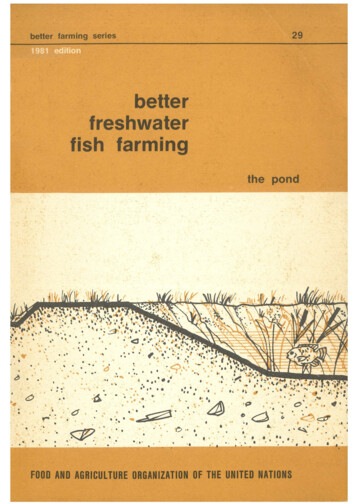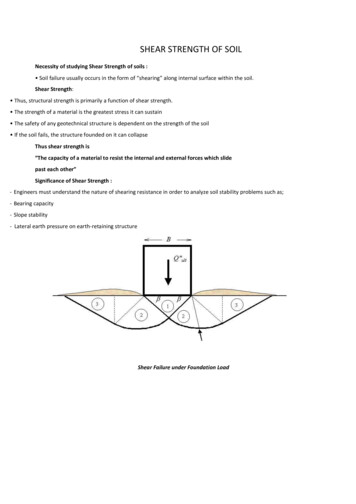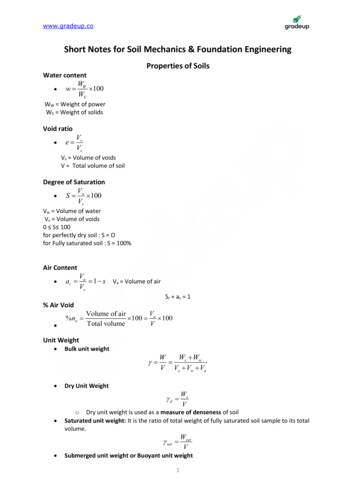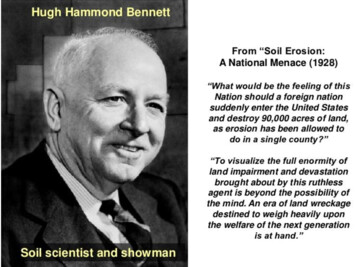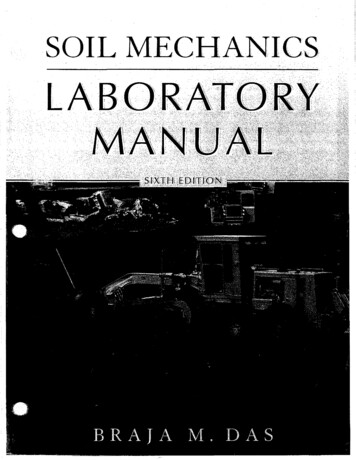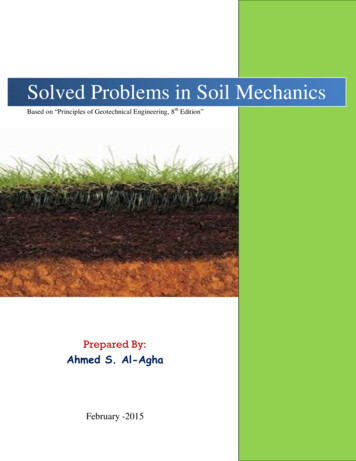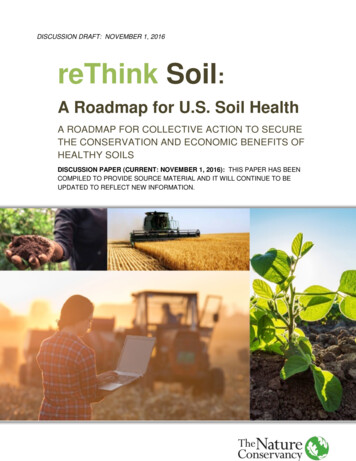
Transcription
DISCUSSION DRAFT: NOVEMBER 1, 2016reThink Soil:A Roadmap for U.S. Soil HealthA ROADMAP FOR COLLECTIVE ACTION TO SECURETHE CONSERVATION AND ECONOMIC BENEFITS OFHEALTHY SOILSDISCUSSION PAPER (CURRENT: NOVEMBER 1, 2016): THIS PAPER HAS BEENCOMPILED TO PROVIDE SOURCE MATERIAL AND IT WILL CONTINUE TO BEUPDATED TO REFLECT NEW INFORMATION.
DISCUSSION DRAFT: NOVEMBER 1, 2016reThink Soil:A Roadmap for U.S. Soil HealthProject Leader:Michael Doane, Director, Working LandsPrimary Contributors:Larry Clemens, Director, North American AgricultureRandy Dell, Great Lakes, Agriculture Strategy ManagerPipa Elias, Senior Policy Advisor, Lands & ClimateJonathan R.B. Fisher, Senior Conservation ScientistJeff Fore, West Tennessee Program DirectorDayna Gross, Senior Conservation ManagerGina Hancock, Conservation Strategy DirectorTom Hodgman, Director, Conservation Transactions, NatureVestAmy Jacobs, Director, Watershed RestorationBill Toomey, Director, Forest Health ProtectionCarrie Vollmer-Sanders, Nutrient Strategy ManagerGreg Wandrey, Iowa Agriculture Program DirectorAcknowledgements:We acknowledge and deeply appreciate the generous support of General Mills for making thisproject possible. In addition to those named, nearly 50 subject matter experts shared their timeand knowledge to help us develop and complete this project. Ten external reviewers made animportant contribution to this project with their constructive assessments of earlier versions of thispaper. Finally, we wish to thank the Context Network for providing project management, subjectmatter expertise, analytical modeling and development of the strategy and recommendations. TheNature Conservancy retained full editorial control over this research and the content of this paper.
DISCUSSION DRAFT: NOVEMBER 1, 2016Table of ContentsExecutive summary1Situation analysis: Why we need a roadmap for soil health7Loss of soil organic carbon (SOC)7Potential benefits of soil conservation management systems10The science of soil health12Momentum building toward soil health14Size of the prize: Measuring the benefits of soil health21Roadmap for action: 10 recommendations29Conclusion42Appendices44Appendix A: Size of the prize assumptions, estimates, and approach44Appendix B: Soil health glossary55Appendix C: Additional soil health resources57Citations58
DISCUSSION DRAFT: NOVEMBER 1, 2016Executive summarySoil health is inextricably linked to broader conservation goalsImproving soil health on U.S. agricultural land holds the potential for achieving meaningfulconservation and economic benefits, as well as mitigating the growing threat of climate change.Healthy soil is the cornerstone of life on earth, facilitating ecosystem biodiversity, ample foodproduction, effective water filtration and storage, and carbon sequestration.Advancements in agricultural technology throughout the past century have allowed farmers to feed apopulation that has grown from less than 2 billion people to more than 7 billion today. Over the sametime period, however, soil managed for agricultural purposes in the U.S. has degraded, losing asmuch as 60% of its original organic carbon content. 1 The degradation of soils has undermined theproductivity of farmers and the resilience of croplands while leading to significant direct and indirectenvironmental impacts annually on a national level: 346 million metric tons of greenhouse gas emissions 4.4 billion pounds of nutrient loss to the environment 996 million metric tons of soil erosion48.4 million acre-feet of water used for irrigation 5234Drawing upon respected analyses in soil health literature, The Nature Conservancy estimates theannual societal and environmental costs of the status quo are up to 85.1 billion annually throughunintended effects on human health, property, energy, endangered species, loss of biodiversity,eutrophication, contamination, agricultural productivity, and resilience. As global food demandgrows, U.S. agriculture needs to be competitively positioned to increase production to meet bothdomestic and international food requirements. Managing for soil health serves as a nexus forachieving increased production while reducing the societal and environmental impacts of the currentU.S. row crop production system.Improving soil health can yield significant benefitsThe U.S. Department of Agriculture’s (USDA) Natural Resources Conservation Service (NRCS)1Lal, R. (2004) Soil Carbon Sequestration Impacts on Global Climate Change and Food Security. Science. Vol 304 pp 1623-1627 SpecialSection: Soils-The Final Frontier.2As estimated using USDA ERS data of fossil fuel combustion, crop residue burning, and soil b-details/?pubid 47481)3As estimated using average nitrogen application reported by USDA ERS and typical leaching as reported by a USDA NRCS izer-use-and-price.aspx, Tables 10, 22, 28 /national/landuse/crops/?cid nrcs143 014202)4As estimated using USDA NRCS figures for wind and water etail/national/technical/nra/nri/results/?cid stelprdb1041678)5As estimated using figures from a USDA ERS report (http://www.ers.usda.gov/media/884158/eib99.pdf)1
DISCUSSION DRAFT: NOVEMBER 1, 2016defines soil health as “the continued capacity of the soil to function as a vital living ecosystem thatsustains plants, animals, and humans.” The concept of adaptive management is inherent in this wellaccepted definition. Adaptive management for soil health means minimizing soil disturbance whileoptimizing plant diversity, allowing more continuous plant and residue covers to create vital, livingecosystems in the soil. In turn, the soil nurtures a complex web of microbes with the healthiest soilsoften being those with the greatest diversity and abundance of life. Healthy soil more efficientlystores and recycles carbon, water, and nutrients such as nitrogen and phosphorous.At the farm level, the benefits of improved soil health include higher rates of productivity andprofitability over the long term, as well as reputational value for farmers who put conservation at thecenter of their management approach. At the societal level, the benefits of boosting soil health areeven more profound, including improved water quality, filtration, and storage; richer biodiversity; andreduced greenhouse gas emissions, mitigating the impacts of climate change.In order to estimate the scale of benefits attributable to changes in soil health, the Conservancychose three management practices—reduced tillage, cover cropping, and crop rotations—to serveas proxies for the adaptive soil health systems, which will vary geographically. Reduced tillagedecreases disturbance of the soil, thereby improving the soil’s ability to retain nutrients andsequester carbon dioxide from the atmosphere. Cover cropping between cash crop seasons is aheritage practice that maximizes the time each year that living roots are building soil nutrients andkeeping the surface protected. Diverse crop rotations help build nutrients, limit erosion, and fostersoil carbon sequestration. While these three practices do not represent the full spectrum of soilhealth solutions available, they serve as valuable measurement proxies because of the extensive,validated research on the conservation and economic benefits of each.Economic benefits ( M) of increased adoption by 1% of U.S. corn-soy-wheat acresEconomic Savings ( M) of increased adoption by 1% of U.S.corn-soy-wheat acresTotalHigh Potential SavingsWater SavingsAverage Expected SavingsErosionMinimum Expected SavingsNutrient RunoffGHG Emission0100200300400500600700Restoring soil health can create net economic benefits for farmers while removing environmentaland societal costs associated with intensified agricultural production that will otherwise amass into2
DISCUSSION DRAFT: NOVEMBER 1, 2016an unfunded liability to be passed along to future generations. The Nature Conservancy has a richhistory achieving conservation goals for the most important landscapes in the world, and this mustinclude the agricultural landscapes that meet society’s critical need for food, fiber, and energy, aswell as the people whose livelihoods depend on those lands. The Conservancy views soil healthrestoration as the primary way to bring economic value to farmers while achieving conservationgoals. Yet, this strategy is part of an emerging conservation solution set—which also includestargeted edge-of-field and in-stream solutions for water quality and more precise nutrientmanagement timed to plant needs.Barriers to achieving soil health are multifacetedA small yet influential segment of farmers, including organic farmers, have catalyzed a movementtoward a new array of both innovative and heritage soil health practices that protect and build soils.Despite these e orts, widespread adoption of soil health systems appears unlikely unless themultiple barriers to adoption are systemically identified and addressed. These barriers, which areundeniably complex, cluster around three key areas: science, economics, and policy.First, the science of soil health is still evolving. Accurate, standardized, and cost-effective on- fieldsoil health measurement tools have yet to be developed and widely implemented. As a result, soilhealth is not easily measured, thus limiting the ability for timely management responses by farmers,or the development of useful policy and economic signals in the marketplace. Likewise farmerscontemplating this change need more evidence and demonstration of operational strategies locallytailored for integrating specific soil health practices on their farms.Second, current business models between landowners, farmers, and agricultural retailers do notadequately encourage soil health management. Conservation systems and practices to restore soilhealth introduce potential operational complexities and may require farmers to make higher capitalor variable cost outlays in the short term. Recouping these investments requires a longer planninghorizon. Yet the majority of farmers in the U.S. lease the land they manage. While lease terms vary,most incent short-term planning and do not allow the farmer to recover costs or plan for a longerhorizon. Large segments of landowners have not been brought into the broader conversation aboutthe value of soil health improvements for society and land value. Therefore, lease arrangements donot adequately factor in soil health improvements. Likewise, agricultural retailers are often trustedadvisors to farmers, and opportunities exist for engaging retailers in providing agronomic knowledgeabout the transition to soil health systems as well as selling products and services designed toimprove soil health.Finally, public policy has not been fully developed and implemented to encourage landowners andfarmers to reduce production risk and support soil health investments requiring longer planninghorizons. Given the value creation potential to address important social and environmentalchallenges, broadening the coalition of interested stakeholders who advocate for theseimprovements in state and federal policies is essential.A roadmap to transform the agricultural management paradigm3
DISCUSSION DRAFT: NOVEMBER 1, 2016A notable change is underway, and momentum is gathering around the opportunity presented by soilhealth systems. The Nature Conservancy is not alone in recognizing the potential of soil health to bethe catalyst for delivering conservation and productivity benefits at a meaningful scale.Innovative initiatives by government agencies such as USDA, NRCS, and the U.S. Department ofEnergy (DOE), as well as newer public-private entities such as the Soil Health Partnership and theSoil Health Institute, are already making import- ant progress. The Conservancy is partnering withthese e orts and other public and private sector organizations to help further a paradigm shift, butgreater coordination, innovation, and investment is still needed.Rather than a constellation of well-intended efforts, the Conservancy calls for a coordinated andaligned approach toward the goal of transforming the U.S. cropland management paradigm, with soilhealth becoming the leading indicator of economic and environmental outcomes on the majority( 50%) of farms by 2025. In doing so, we can significantly improve the pace and certainty ofreversing the negative trends on water quality over the next decade while establishing one of themost cost effective natural climate solutions. Specific and measureable benefits of attaining theproposal goal in the U.S. are summarized on an annual basis: Mitigating 25 million metric tons of greenhouse gas emissions,Reducing 344 million pounds of nutrient loss to the environment,Eliminating 116 million metric tons of soil erosion,Creating 3.6 million acre-feet of available water capacity in cropland soils.Taken together, these improvements will create a diverse basket of environmental and socialbenefits valued at 7.4 billion annually. Through higher rates of productivity resulting from higheryields or lower production costs, farmers stand to gain modest, albeit meaningful net economicbenefits of 37 million for each one percent of cropland transformed, or 1.2 billion annually acrossthe U.S. corn belt. The Conservancy proposes a roadmap for collective action to secure theconservation and economic benefits of healthy soils. Coordinated and collective actions across tenpriorities spanning science, economic, and policy outcomes will overcome the multiple barriers towidespread adoption. The roadmap is offered as a starting point for greater collaboration. In time, itwill conform to the combined knowledge and capacity of committed partners, as well as the evolvingstate of the science, economics, and public policy environment regarding soil health.Overcome the science and research gap to support expansion of soil healthmanagement:1. Create cost-effective soil health measurement standards and toolsCreate accurate, accessible, and standardized methods for rapidmeasurement of key soil health indicators at a scale that impactsmanagement choices by farmers and landowners4
DISCUSSION DRAFT: NOVEMBER 1, 20162. Develop operational management strategies for adaptivelyintegrating soil health practices and systemsBuild evidence and understanding among farmers of operationalstrategies and regional variabilities for integrating multiple soilhealth practices on a farm, including optimal cover crop programs3. Advance the science of soil health benefitsFurther quantify the economic costs and benefits and environmentalimpacts of different management systems on soil health, withconsideration for different regions, soil types, and cultural practices.Overcome economic obstacles by providing the market systems tosecure soil health by:4. Align incentives between landowners and farmersCultivate the economic case for action among absentee landownersof soil health benefits for society and land value and encourage newlease arrangements that integrate soil health systems and practices5. Leverage technological innovation to overcome operational hurdlesLeverage technological innovations, such as sensors, drones, covercrop seeding equipment, precision agriculture software andhardware, to advance adoption and continued implementation ofsoil health systems and practices6. Provide broader access to products and services supporting soilhealthDevelop new business models with agricultural retailers that providebroader access to new products and services to accelerate theadoption of soil health systems and practices7. Create market signals in sustainability programs for soil healthDevelop improved indicators that reward soil health managementoutcomes in sustainability assessment programs, aligning theincentives of farmers and societyImprove the policy environment to advance soil health:8. Reward farmers who optimize long-term soil health withlower crop insurance premiumsAdvocate for federally subsidized crop insurance programs to valuethe benefits generated from improved soil health profiles throughlower insurance premiums.5
DISCUSSION DRAFT: NOVEMBER 1, 20169. Support policies that enable greater investment in soil healthSupport state and federal policy improvements that focus onreducing barriers to soil health practice adoption, target priorityareas for implementation, and comprehensively assess impacts forsocietal value10. Build a more diverse constituency for soil health policyBuild a strong and diverse network of supporters for soil healthpolicy, including farmers, landowners, the agri-food sector,community leaders, and societal interest groupsConclusions and invitationManaging U.S. croplands for soil health offers an exciting value proposition to farmers and society.The Nature Conservancy is compelled—by both our mission and the size of the benefits for peopleand nature—to lend our support to this important cause. In doing so, we intend to bring about a moreconcerted and coordinated effort, accelerating the adoption of soil health systems and achievingeconomic and environmental outcomes at a scale that addresses our most pressing global challenges.The Conservancy is committed to expanding our capacity to seize this important and timelyopportunity. The science agenda for soil health will require significant, long-term investments andcollaborations. The Conservancy is expanding scientific capacity through the addition of a new leadscientist role for soils. As such, the Conservancy will be a more capable partner with organizationscharting the future of soil health research. It is clear new business models will be necessary to alignthe economic interests of farmers, landowners and agricultural retailers on soil health benefits. TheConservancy seeks to be a collaborative and positive force for the advancement of new value creationopportunities. Expanding on the successful model of the Soil Health Partnership will be a priority giventhe importance of farmer-to-farmer knowledge transfer with adaptive and locally tailored soil healthsolutions. The Conservancy has actively engaged in discussions about the current and futureopportunities for improved public policies in support of soil health at the state and federal level. Theseefforts include targeting existing conservation programs for the highest impact as well as policyplanning efforts on the future of crop insurance. The Conservancy’s network of state chapters andtrustees can serve as executive advocates for public policies in support of the soil healthmovement. The Nature Conservancy invites interested organizations and individuals to sharefeedback and expressions of interest in the ideas articulated in this paper by emailing soil@tnc.org.6
DISCUSSION DRAFT: NOVEMBER 1, 2016Situation analysisSoils are essential to multiple life support systems frequently taken for granted,such as water cycle, carbon cycle and nitrogen cycle, in addition to being thefoundation of our food systems. Increasingly, farmers, scientists, landowners,environmental experts, and policymakers understand soil health is a keystoneissue and that addressing its complex challenges is urgently essential. Whilethe health of soil is influenced by some inherent factors such as formation,geography, and climate, other factors are more dynamic and influenced by howthe soil is managed.Loss of soil organic carbonHistorically, as open prairies in the United States were converted to cropland,rich soils began to gradually degrade through erosion, loss of organic content,contamination, compaction, increased salinity, and other problems. 6 Over time,regions like the U.S. Heartland, where crop production is highly concentrated(Figure 1), have been deeply impacted by the environmental demands ofintensified productivity.6Oliver & Gregory, 20157
DISCUSSION DRAFT: NOVEMBER 1, 2016Figure 1: Highly concentrated regions of crop production in the U.S.Source: USDA Census of Agriculture8
DISCUSSION DRAFT: NOVEMBER 1, 2016At the crux of this issue is soil organic carbon (SOC),or more specifically, the loss of it. SOC is the portionof soil organic matter that is made up of carbon, andit is increasingly recognized as a proxy indicator ofsoil health. 7 Soil interacts with other naturalresources like air and water and, ideally, is rich withorganic matter formed through the naturalinterchange with plants. Living and decomposingplant matter feeds many kinds of organisms, which inturn produce an array of biological organiccompounds. Higher SOC levels are considered bymany soil scientists as an indicator of soils that areresilient, agriculturally productive, and more capableof withstanding environmental pressures. 8While some organic matter in the soil is quick tobreak down where it may return to the atmosphereas CO2, other portions are stable, or “recalcitrant”, formany years and can thus serve as carbon sinks,absorbing and storing CO2 from the atmosphere. 9Soil Health Calls Upon a Wide Arrayof PracticesImproving soil health in the U.S. willinvolve a dynamic, continually adaptiveprocess and a broad range of practicesthat vary from region to region, andeven from farm to farm within a regionAlthough the estimation of benefitslater in this paper highlights three soilhealth practices that have been morecomprehensively studied, farmers andscientists are using and investigating amuch broader array of soil healthpractices. These include: Cover cropsCrop rotationsReduced or No till systemsIntegrating livestockSoil amendments, includingbiocharAdaptive nutrient, pest, and weedmanagemento Sustainable nutrientmanagement, conservationnutrient management,4RPlus, precision agricultureand precision conservationo Integrated pest management,biological pest control, avoidsoil fumigation and use ofpersistent pesticideso Weed management systems,including consideration of rowspacing, crop selection, rollercrimpers, etc.Common cultivation techniques used over the lastcentury involving tillage, such as plowing, disking,and chiseling, as well as monocropping, break downthe soil mechanically and biologically, diminishsufficient supplies of oxygen for soil biota and plants,deplete nutrients, increase soil erosion, reduceaggregate stability and water-holding capacity, anddecrease levels of organic matter, as measured bySources: NRCS, CCSI, RodaleSOC. 10 The greatest loss of SOC related toagriculture generally occurs during the first 25 years of cultivation, with lossesof 50% being common. 11 In the Midwest, the majority of soils converted fromnatural to agricultural systems have lost 60% or more of the original SOC level.As SOC levels dropped, the need to fertilize more to compensate rose, whichcan be a factor in increased nutrient loss.7Lehmann & Kleber, 20158Reicosky, Sauer & Hatfield, 20119Sanderman, Baisden, & Fallon, 201510Six & Paustian, 201411Overstreet & DeJong, 20099
DISCUSSION DRAFT: NOVEMBER 1, 2016The impacts of these common agricultural practices, coupled with SOC losses,are manifold: farms cannot achieve their maximum productivity; nutrients in thesoil are lost due to erosion and water runoff; nitrate and phosphoruscontamination – a consequence associated with fertilizer loss – compromisesthe quality of groundwater and waterways; and substantial amounts ofgreenhouse gases naturally stored in the soil return to the atmosphere.Conversely, through the use of practices that promote soil health, many ofthese impacts can be reversed as SOC and other key soil properties improve,as described in the following section.Potential benefits of soil conservation management systemsSoil conservation management systems in agriculture that are aimed atrestoring SOC can lessen and even reverse the environmental impacts, andindividual farmers who have adopted such systems are already seeingmeasurable improvements in soil health, including higher yields and less needfor nutrient purchases (see “Farmer Profiles”, page 10). These systems includecover crop planting, more crop rotation, and decreased tillage, and each showspotential for farm-level and societal benefits, including: On-farm productivity and profitability: Increases in the soil’s carboncontent can lead to overall better soil health, improved water infiltrationand retention, improved nutrient retention, and better crop rooting, all ofwhich contribute to potentially higher productivity and profitability. 12 It islikely that land owners, including corporations, municipalities andindividuals, can realize healthier, more productive land that may translateinto higher land value. Reduced greenhouse gas emissions: Achieving even small increasesor preventing reductions in the soil’s carbon content can mitigate theemission of greenhouse gases like methane and nitrous oxide to theatmosphere. The NRCS has ranked the potential of various soil healthsystems, and the National Sustainable Agriculture Coalition has alsoreviewed the potential of these systems. 13 In addition, the COMET-FarmTool was developed through a partnership between Colorado StateUniversity and the USDA-NRCS as a means of accounting for the carbonsequestration contributions of conservation practices.12Paustian, Lehmann, Ogle, Reay, Robertson & Smith, 201613Kane, 201510
DISCUSSION DRAFT: NOVEMBER 1, 2016 Nutrient loss reduction: Phosphorus and nitrogenare oftenin theSoil HealthFarmerlostProfiles:David Brandt1,100 acres in OhioCorn, soy, wheatNo-till since 1971Cover crops: all mixes since 1978Brandt has reduced his nutrientpurchases by 80%. He graduallymoved from single species of covercrops to 10 species, first using singlespecies such as nitrogen-fixing speciesto reduce input costs from legumecovers. Next, he planted two covercrop species to absorb the availablephosphorus and potash, and thenexpanded to additional cover cropspecies.Yield: Currently yield is 12% betterthan county average (for corn, 180-200compared to country average 140-160;beans stay healthier and yield better,70-80 with rye covers)Source: NRCS websiteTim SmithIowa farmer, Soil Health Partnership800 acres, corn and soybeansSmith started using rye as a cover cropon 300 acres. He expanded to 550acres and added oats, hairy vetch, andradishes, in different combinations. Hereceived the National Corn GrowersAssociation Good Steward award.Benefits: prevention of nitrate leachingand erosion; enhancedmicroorganisms; and complementarywith his practices such as strip-till.He admits that there is a learningcurve. It took several years for clearresults because of different weatherpatterns.Source: Soil Health Partnership websiteMark and Doug AnsonIndiana/Illinois farmersThe Anson brothers started usingcover crops in 2010. It took three yearsto make one of the brothers a believer,during a drought year.Source: New York Times11
DISCUSSION DRAFT: NOVEMBER 1, 2016form of soil erosion and leaching, especially in tile drained systems.Increased soil organic matter can bind the soils with these nutrients toreduce loss. Cover cropping helps store those nutrients in biomassduring the non-crop season. 14 Less water runoff: General improvement of soil health, particularlyoptimal aggregate structure, permeability, and carbon content, can resultin less water runoff, better aeration, increased water penetration, andincreased water retention. 15 Further, nitrate content may be reduced inground water that affects both on-farm and municipal water supplies. 16 Less erosion: Healthy and well managed fields have a much lowerpotential for soil loss due to wind and/or water erosion, particularly duringsevere weather events. 17 Mitigation of soil loss via erosion not onlymaintains the value of the farm, but also alleviates downstream impactsof eroded soil such as sedimentation and biodiversity losses inwaterways. 18The science of soil healthThe complexity of the issue is reflected in efforts to simply define what “soilhealth” means. There is not yet a single definition, although an emergingconsensus generally aligns with the NRCS and USDA description as “thecontinued capacity of soil to function as a vital living ecosystem that sustainsplants, animals, and humans.” The Nature Conservancy fully supports thisdefinition of soil health, recognizing that it will evolve as the science does.14Deng et al, 201615Overstreet & DeJong, 200916Associated Press, January 7, 201517Motha, 201118Paustian et al, 201612
DISCUSSION DRAFT: NOVEMBER 1, 2016Nonetheless, the science of soil health, namelyNew Soil Health Testshow to best define and measure it, how to bestpromote it, and how it supports other objectives,The Haney Test, developed at theremains a work in progress. Several long-heldTemple, TX, USDA Ag Researchtenets of soil science have been challenged inService laboratory by Rick Haney andrecent years, from the role of no-till agriculture incolleagues, evaluates how much "food"the soil food web has available to it.boosting soil carbon, to how soil decomposes –and how stable the resulting compounds are – toThis test aims to replicate fieldhow different types of soil carbon behave. Effortsconditions by using customized soilto improve soil health face two interconnectedextraction processes including:problems: what soil health means (which of the H3A soil extractant that mimicscomponents of soil health are most important) andsoil solutions by using organichow to measure it (which indicators are mostacids produced by living plantroots.appropriate and useful). Scientists have developed Solvita 1-day CO2 Burst usesseveral generally accepted indicators of thedrying and rewetting techniques tocomponents of soil health, including the amount ofmimic natural field events,organic and particulate organic matter, waterrepresenting the flush of microbialactivity leading to nutrient cycling.infiltration and water holding capacities, bulkdensity and aggregate stability, aeration, biologicalThe test al
Executive summary 1 Situation analysis: Why we need a roadmap for soi l health 7 Loss of soil organic carbon (SOC) 7 Potential benefits of soil conservation management systems 10 The science of soil health 12 Momentum building toward soil health 14 Size of the prize: Measuring the benefits of soil health 21




